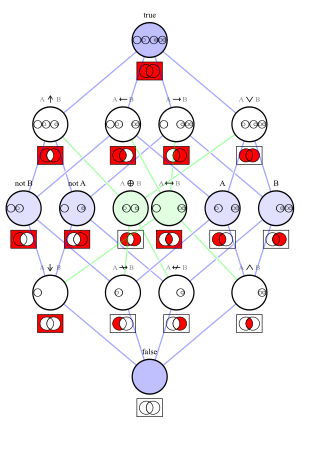
In logic, a logical connective is a logical constant. Connectives can be used to connect logical formulas. For instance in the syntax of propositional logic, the binary connective can be used to join the two atomic formulas and , rendering the complex formula .
In propositional logic, modus ponens, also known as modus ponendo ponens, implication elimination, or affirming the antecedent, is a deductive argument form and rule of inference. It can be summarized as "P implies Q.P is true. Therefore, Q must also be true."

The raven paradox, also known as Hempel's paradox, Hempel's ravens, or rarely the paradox of indoor ornithology, is a paradox arising from the question of what constitutes evidence for the truth of a statement. Observing objects that are neither black nor ravens may formally increase the likelihood that all ravens are black even though, intuitively, these observations are unrelated.
In mathematics and logic, a vacuous truth is a conditional or universal statement that is true because the antecedent cannot be satisfied. It is sometimes said that a statement is vacuously true because it does not really say anything. For example, the statement "all cell phones in the room are turned off" will be true when no cell phones are in the room. In this case, the statement "all cell phones in the room are turned on" would also be vacuously true, as would the conjunction of the two: "all cell phones in the room are turned on and turned off", which would otherwise be incoherent and false.

In logic, negation, also called the logical not or logical complement, is an operation that takes a proposition to another proposition "not ", standing for " is not true", written , or . It is interpreted intuitively as being true when is false, and false when is true. Negation is thus a unary logical connective. It may be applied as an operation on notions, propositions, truth values, or semantic values more generally. In classical logic, negation is normally identified with the truth function that takes truth to falsity. In intuitionistic logic, according to the Brouwer–Heyting–Kolmogorov interpretation, the negation of a proposition is the proposition whose proofs are the refutations of .
Relevance logic, also called relevant logic, is a kind of non-classical logic requiring the antecedent and consequent of implications to be relevantly related. They may be viewed as a family of substructural or modal logics. It is generally, but not universally, called relevant logic by British and, especially, Australian logicians, and relevance logic by American logicians.
In natural languages, an indicative conditional is a conditional sentence such as "If Leona is at home, she isn't in Paris", whose grammatical form restricts it to discussing what could be true. Indicatives are typically defined in opposition to counterfactual conditionals, which have extra grammatical marking which allows them to discuss eventualities which are no longer possible.
Counterfactual conditionals are conditional sentences which discuss what would have been true under different circumstances, e.g. "If Peter believed in ghosts, he would be afraid to be here." Counterfactuals are contrasted with indicatives, which are generally restricted to discussing open possibilities. Counterfactuals are characterized grammatically by their use of fake tense morphology, which some languages use in combination with other kinds of morphology including aspect and mood.
Conditional sentences are natural language sentences that express that one thing is contingent on something else, e.g. "If it rains, the picnic will be cancelled." They are so called because the impact of the main clause of the sentence is conditional on the dependent clause. A full conditional thus contains two clauses: a dependent clause called the antecedent, which expresses the condition, and a main clause called the consequent expressing the result.
Dialetheism is the view that there are statements that are both true and false. More precisely, it is the belief that there can be a true statement whose negation is also true. Such statements are called "true contradictions", dialetheia, or nondualisms.

The material conditional is an operation commonly used in logic. When the conditional symbol is interpreted as material implication, a formula is true unless is true and is false. Material implication can also be characterized inferentially by modus ponens, modus tollens, conditional proof, and classical reductio ad absurdum.
In logic, a strict conditional is a conditional governed by a modal operator, that is, a logical connective of modal logic. It is logically equivalent to the material conditional of classical logic, combined with the necessity operator from modal logic. For any two propositions p and q, the formula p → q says that p materially implies q while says that p strictly implies q. Strict conditionals are the result of Clarence Irving Lewis's attempt to find a conditional for logic that can adequately express indicative conditionals in natural language. They have also been used in studying Molinist theology.
Deontic logic is the field of philosophical logic that is concerned with obligation, permission, and related concepts. Alternatively, a deontic logic is a formal system that attempts to capture the essential logical features of these concepts. It can be used to formalize imperative logic, or directive modality in natural languages. Typically, a deontic logic uses OA to mean it is obligatory that A, and PA to mean it is permitted that A, which is defined as .
In philosophical logic, the concept of an impossible world is used to model certain phenomena that cannot be adequately handled using ordinary possible worlds. An impossible world, , is the same sort of thing as a possible world , except that it is in some sense "impossible." Depending on the context, this may mean that some contradictions, statements of the form are true at , or that the normal laws of logic, metaphysics, and mathematics, fail to hold at , or both. Impossible worlds are controversial objects in philosophy, logic, and semantics. They have been around since the advent of possible world semantics for modal logic, as well as world based semantics for non-classical logics, but have yet to find the ubiquitous acceptance, that their possible counterparts have found in all walks of philosophy.
In metalogic and metamathematics, Frege's theorem is a metatheorem that states that the Peano axioms of arithmetic can be derived in second-order logic from Hume's principle. It was first proven, informally, by Gottlob Frege in his 1884 Die Grundlagen der Arithmetik and proven more formally in his 1893 Grundgesetze der Arithmetik I. The theorem was re-discovered by Crispin Wright in the early 1980s and has since been the focus of significant work. It is at the core of the philosophy of mathematics known as neo-logicism.
The paradoxes of material implication are a group of true formulae involving material conditionals whose translations into natural language are intuitively false when the conditional is translated as "if ... then ...". A material conditional formula is true unless is true and is false. If natural language conditionals were understood in the same way, that would mean that the sentence "If the Nazis had won World War Two, everybody would be happy" is vacuously true. Given that such problematic consequences follow from a seemingly correct assumption about logic, they are called paradoxes. They demonstrate a mismatch between classical logic and robust intuitions about meaning and reasoning.
Dynamic semantics is a framework in logic and natural language semantics that treats the meaning of a sentence as its potential to update a context. In static semantics, knowing the meaning of a sentence amounts to knowing when it is true; in dynamic semantics, knowing the meaning of a sentence means knowing "the change it brings about in the information state of anyone who accepts the news conveyed by it." In dynamic semantics, sentences are mapped to functions called context change potentials, which take an input context and return an output context. Dynamic semantics was originally developed by Irene Heim and Hans Kamp in 1981 to model anaphora, but has since been applied widely to phenomena including presupposition, plurals, questions, discourse relations, and modality.
Exportation is a valid rule of replacement in propositional logic. The rule allows conditional statements having conjunctive antecedents to be replaced by statements having conditional consequents and vice versa in logical proofs. It is the rule that:
Free choice is a phenomenon in natural language where a linguistic disjunction appears to receive a logical conjunctive interpretation when it interacts with a modal operator. For example, the following English sentences can be interpreted to mean that the addressee can watch a movie and that they can also play video games, depending on their preference:
- You can watch a movie or play video games.
- You can watch a movie or you can play video games.
In formal semantics and philosophical logic, simplification of disjunctive antecedents (SDA) is the phenomenon whereby a disjunction in the antecedent of a conditional appears to distribute over the conditional as a whole. This inference is shown schematically below:





